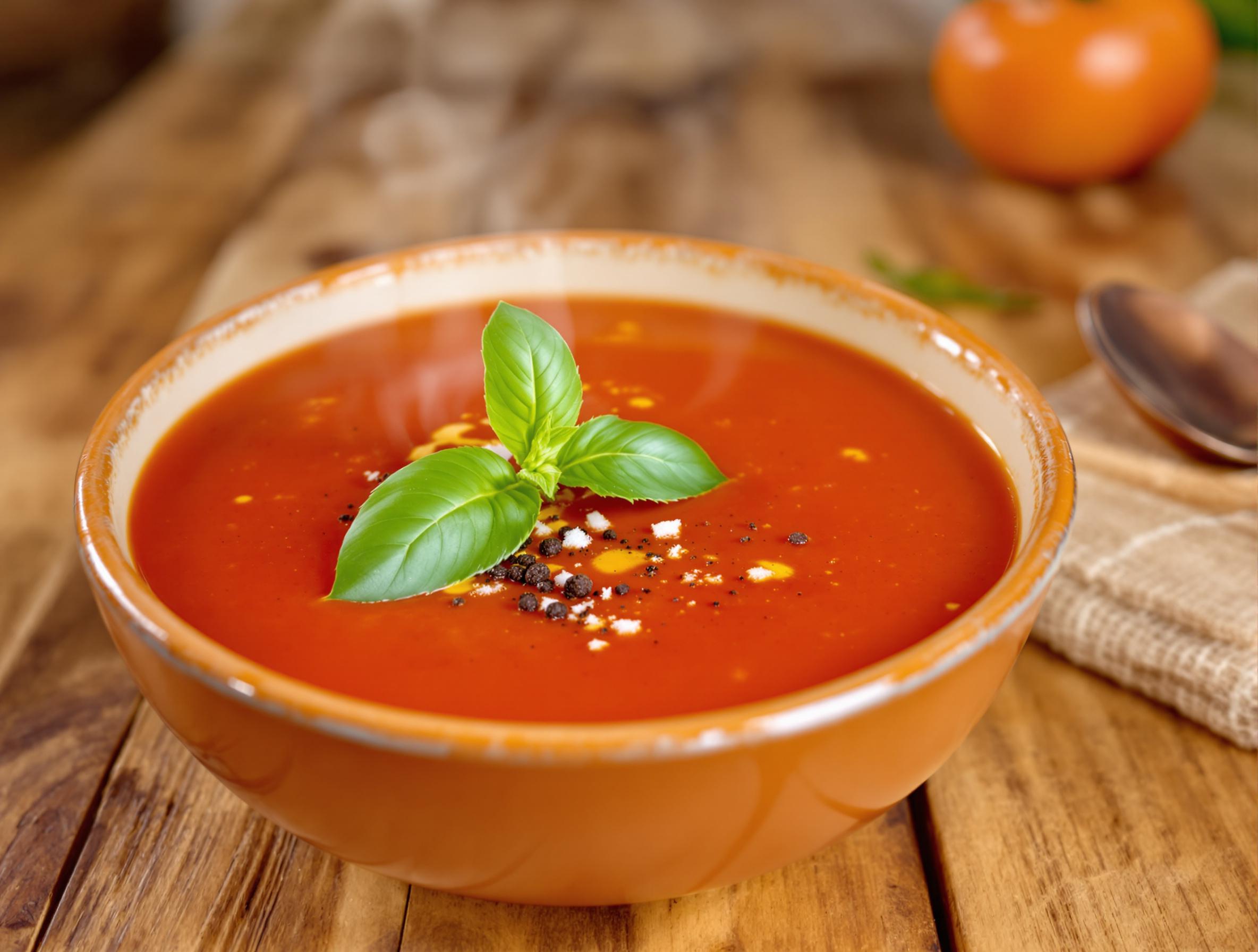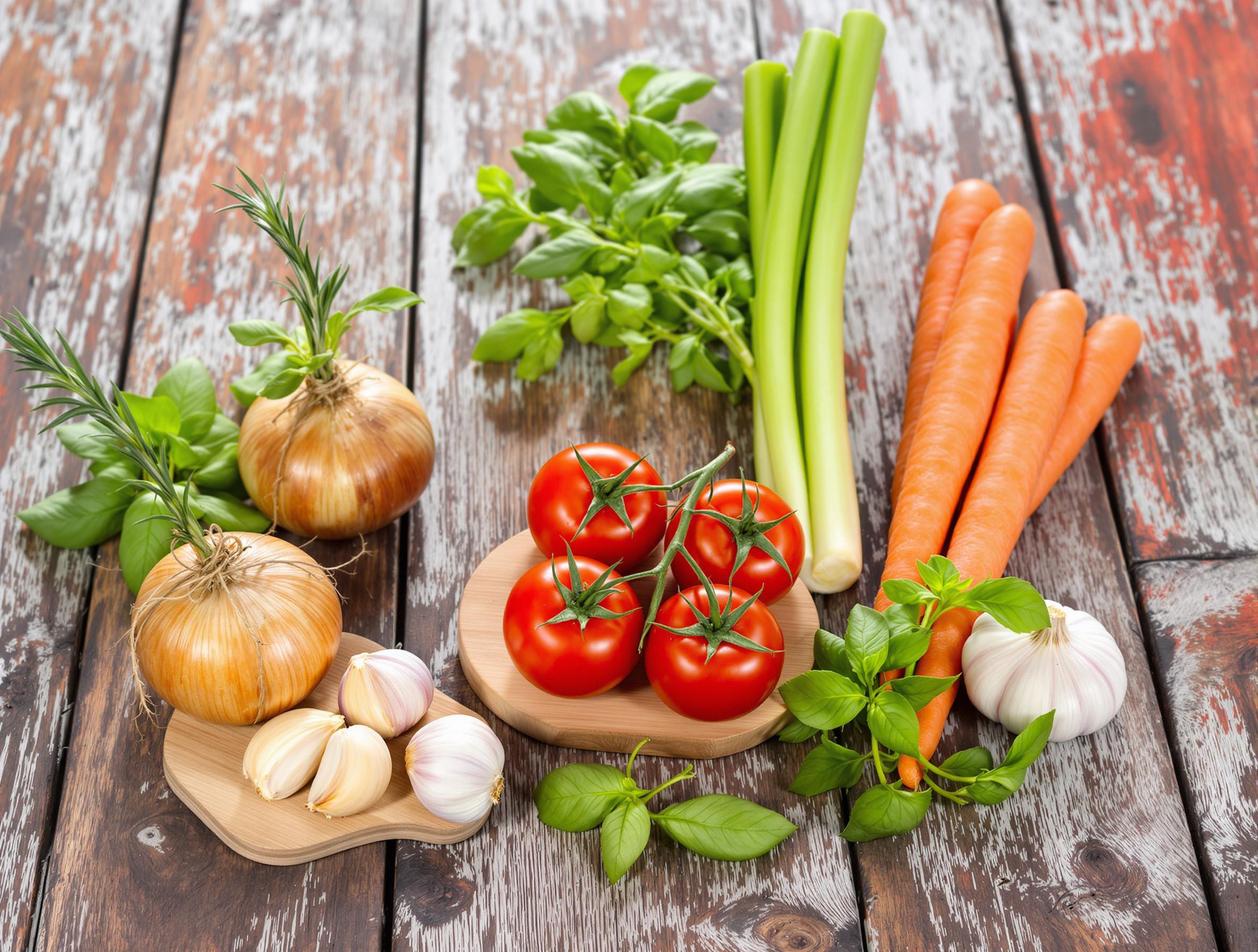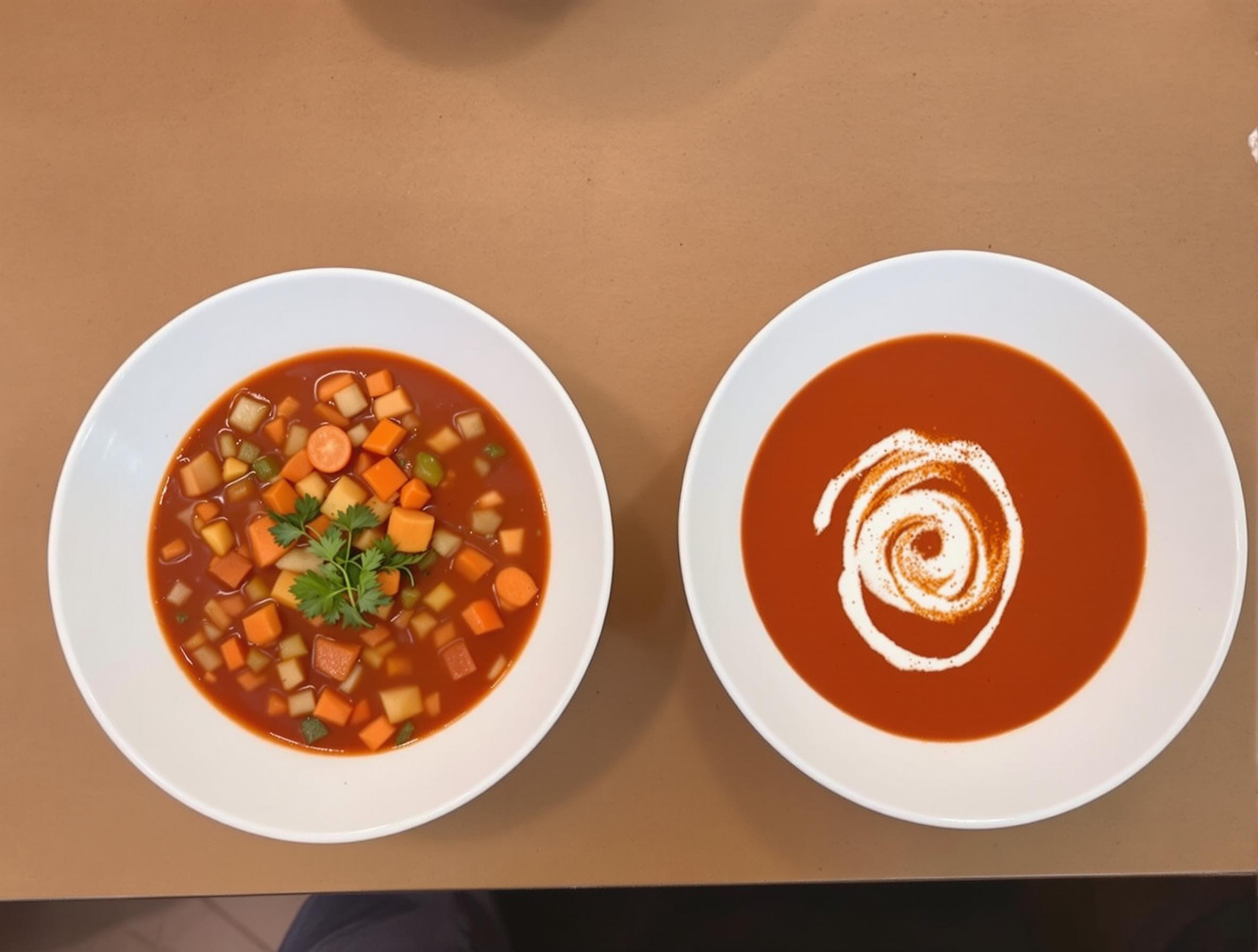Introduction to Tomato Soup vs. Tomato Bisque
In the world of culinary delights, few debates are as intriguing as the one surrounding tomato soup vs. tomato bisque. Both dishes offer comfort and warmth, yet they differ significantly in their ingredients, preparation methods, and culinary uses. Understanding these differences can elevate your cooking skills and appreciation for these classic dishes. Let’s dive into the fascinating world of tomato soup vs. tomato bisque and explore what sets them apart.
Historical Background of Tomato Soup
Tomato soup has been a beloved staple in households worldwide for centuries. Its origins can be traced back to various cultures, each contributing unique twists to the classic recipe. Traditionally, tomato soup is made with simple ingredients like tomatoes, stock, and seasonings. The soup’s versatility has made it a popular choice for quick meals and comfort food. For a deeper dive into the evolution of tomato soup, you can explore resources like Food Timeline, which provides detailed historical context on various foods, including soups.
Evolution of Tomato Soup

The evolution of tomato soup reflects the culinary traditions of various regions. In Italy, for instance, tomato-based soups often incorporate fresh basil and olive oil, reflecting the Mediterranean influence. In contrast, American versions might include a hint of sweetness from added sugar, catering to local preferences. This diversity in recipes showcases how tomato soup has adapted to different cultural tastes and ingredient availability.
Tomato Soup in Modern Cuisine
Today, tomato soup remains a staple in modern cuisine, with countless variations available in restaurants and homes. Its simplicity and comforting nature make it a go-to dish for many, especially during colder months. The versatility of tomato soup allows for numerous adaptations, from spicy versions with a kick of chili to creamy variations that blur the lines with tomato bisque. Modern chefs often experiment with unique ingredients and techniques to create innovative versions of this classic dish.
Historical Background of Tomato Bisque
Tomato bisque, on the other hand, has a rich history rooted in French cuisine. Originally, the term “bisque” referred to a creamy soup made from shellfish. However, over time, the definition has expanded to include cream-based soups made from vegetables, such as tomatoes. The transition from traditional seafood bisques to modern vegetable bisques has been influenced by culinary trends and the desire for more diverse flavor profiles. For more insights into the history of bisques, you can refer to culinary history resources like The Spruce Eats, which offers comprehensive guides on various culinary topics.
The French Influence on Tomato Bisque
The French influence on tomato bisque is evident in its preparation and presentation. Traditional French bisques were made with shellfish, but the technique of creating a smooth, creamy soup has been adapted for vegetable-based bisques. The use of cream and careful blending creates a luxurious texture that is characteristic of French cuisine. This technique has been refined over centuries, making French cuisine renowned for its elegance and sophistication.
Tomato Bisque in Contemporary Dining
In contemporary dining, tomato bisque is often featured on the menus of upscale restaurants. Its rich and indulgent nature makes it a popular choice for special occasions and fine dining experiences. The addition of cream and aromatics elevates the dish, making it a standout option among soup offerings. Modern interpretations of tomato bisque often incorporate unique ingredients and presentation styles to appeal to contemporary palates.
Key Ingredients in Tomato Soup

The primary ingredients in tomato soup include:
- Tomatoes: The star ingredient, providing the base flavor. Fresh tomatoes offer a bright, acidic taste, while canned tomatoes provide consistency and convenience. The quality of tomatoes significantly impacts the soup’s flavor, so choosing ripe, flavorful tomatoes is essential.
- Stock: Chicken or vegetable stock adds depth and richness. The choice of stock can significantly impact the soup’s final flavor. Homemade stock often provides a richer taste compared to store-bought varieties.
- Seasonings: Herbs and spices like basil, garlic, and salt enhance the flavor. Experimenting with different herbs can add unique twists to the classic recipe. Fresh herbs generally provide a more vibrant flavor than dried ones.
- Vegetables: Onions, carrots, and celery are often added for extra taste and texture. These vegetables contribute to the soup’s hearty and comforting nature. Sautéing these vegetables before adding them to the soup can enhance their flavors.
These ingredients combine to create a hearty and comforting soup that is perfect for any occasion. The simplicity of tomato soup allows for endless variations, making it a versatile dish for any kitchen. For more details on how these ingredients come together, you can explore cooking resources like Serious Eats, which offers in-depth guides on cooking techniques and ingredient usage.
Key Ingredients in Tomato Bisque
Tomato bisque shares some ingredients with tomato soup but has a few distinct additions:
- Cream: The defining ingredient, giving tomato bisque its velvety texture. Heavy cream is traditionally used, but some recipes may call for lighter alternatives like milk or coconut cream. The type of cream used can affect the bisque’s richness and flavor.
- Tomatoes: Provides the base flavor, similar to tomato soup. The quality of the tomatoes used can significantly impact the bisque’s overall taste. Using high-quality, ripe tomatoes ensures a robust flavor profile.
- Aromatics: Onions, shallots, and garlic add depth and complexity. These ingredients are often sautéed to release their flavors before being blended into the soup. The sautéing process caramelizes the natural sugars in these aromatics, enhancing the bisque’s flavor.
- Seasonings: Herbs and spices like basil, thyme, and bay leaves enhance the flavor. The careful selection of seasonings can elevate the bisque’s taste profile. Using fresh herbs and properly storing them can maintain their flavor and aroma.
The addition of cream sets tomato bisque apart, creating a rich and indulgent dining experience. The combination of aromatics and seasonings contributes to the bisque’s complex and satisfying flavor. For more details on how these ingredients come together, you can refer to culinary resources like Bon Appétit, which provides recipes and cooking tips from professional chefs.
Preparation Methods for Tomato Soup
Preparing tomato soup involves several key steps:
- Simmering: Cooking the ingredients together to blend flavors. Simmering allows the tomatoes to break down and release their juices, creating a flavorful base. The duration of simmering can affect the depth of flavor, with longer simmering times often resulting in a more intense taste.
- Seasoning: Adding herbs and spices to enhance the taste. The timing of adding seasonings can impact the soup’s final flavor, with some ingredients benefiting from longer cooking times. Adding herbs early in the cooking process allows their flavors to infuse into the soup.
- Blending: Optional, for a smoother texture. Blending the soup can create a velvety consistency, similar to that of a bisque. However, some prefer the chunkier texture of unblended tomato soup. Blending can be done using an immersion blender for convenience or a traditional blender for a smoother result.
These methods ensure that the soup’s flavors are well-integrated and balanced. The preparation of tomato soup is relatively straightforward, making it an accessible dish for home cooks of all skill levels. For more insights into soup preparation techniques, you can explore resources like Fine Cooking, which offers detailed guides on various cooking methods.
Preparation Methods for Tomato Bisque
The preparation of tomato bisque requires special attention to detail:
- Simmering: Cooking the ingredients together to infuse flavors. Simmering allows the aromatics to soften and release their flavors, creating a rich base for the bisque. The simmering process should be done gently to prevent the cream from curdling.
- Blending: Essential for achieving the smooth, creamy texture. Blending ensures that the bisque has a consistent and velvety consistency, free of lumps or chunks. Using a high-powered blender can help achieve a smoother texture.
- Adding Cream: Incorporating cream to create a velvety consistency. The cream should be added slowly and at a low temperature to prevent curdling. Gradually adding the cream while continuously stirring helps maintain the bisque’s smooth texture.
These steps are crucial in creating the luxurious texture that defines tomato bisque. The careful preparation of tomato bisque results in a sophisticated and indulgent dish that is perfect for special occasions. For more information on preparing cream-based soups, you can refer to resources like Epicurious, which provides recipes and cooking tips from culinary experts.
Nutritional Comparison of Tomato Soup vs. Tomato Bisque
When comparing the nutritional profiles of tomato soup vs. tomato bisque, several differences emerge:
- Calories: Tomato bisque tends to be higher in calories due to the addition of cream. The calorie content can vary based on the type and amount of cream used. Opting for lighter cream alternatives or reducing the amount of cream can help manage the calorie content.
- Fat Content: Tomato bisque has a higher fat content, contributing to its rich flavor. The fat content can be adjusted by using lighter cream alternatives or reducing the amount of cream used. Choosing low-fat or non-dairy cream substitutes can make the bisque healthier without compromising its creamy texture.
- Vitamins and Minerals: Both soups offer essential vitamins and minerals, but their profiles may vary based on ingredients. Tomatoes are a rich source of vitamin C and lycopene, which offer numerous health benefits. Incorporating additional vegetables or herbs can further enhance the nutritional value of these soups.
Understanding these nutritional differences can help you make informed choices when enjoying these soups. The nutritional content of tomato soup vs. tomato bisque can be adjusted to suit various dietary needs and preferences. For more detailed nutritional information, you can consult resources like NutritionData, which provides comprehensive nutritional analyses of various foods.
Culinary Uses and Pairings for Tomato Soup vs. Tomato Bisque

Tomato soup vs. tomato bisque can be enjoyed in various culinary settings:
- Tomato Soup: Pairs well with grilled cheese sandwiches or crusty bread. The classic combination of tomato soup and grilled cheese is a comfort food staple that appeals to both children and adults. The simplicity of tomato soup makes it a versatile dish that can be served as a main course or a side dish.
- Tomato Bisque: Ideal as a starter or a main course, complemented by croutons or a side salad. The rich and creamy nature of tomato bisque makes it a versatile dish that can be served in various settings, from casual lunches to elegant dinners. Its sophisticated flavor profile allows it to be paired with a variety of accompaniments, such as seafood or gourmet cheeses.
These pairings enhance the dining experience and showcase the versatility of both dishes. The culinary uses of tomato soup vs. tomato bisque are vast, making them popular choices for home cooks and professional chefs alike. For more ideas on pairing soups with other dishes, you can explore resources like Food & Wine, which offers creative culinary inspirations.
Cultural Significance and Variations of Tomato Soup vs. Tomato Bisque

The cultural significance of tomato soup vs. tomato bisque varies across regions:
- Tomato Soup: A comfort food staple in many cultures, with regional variations in ingredients and preparation methods. In the United States, tomato soup is often associated with childhood memories and simple, home-cooked meals. Its accessibility and simplicity have made it a beloved dish in many households.
- Tomato Bisque: Often associated with fine dining, reflecting its French culinary roots. The indulgent nature of tomato bisque makes it a popular choice for special occasions and upscale dining experiences. Its rich and creamy texture is often highlighted in gourmet settings, where it is served as an elegant starter or main course.
Exploring these cultural variations can deepen your appreciation for these classic dishes. The cultural significance of tomato soup vs. tomato bisque highlights the diverse and rich culinary traditions that have shaped these dishes over time. For more insights into the cultural significance of various foods, you can refer to resources like National Geographic, which explores the cultural and historical contexts of food around the world.
FAQs Section on Tomato Soup vs. Tomato Bisque
What is the Difference Between Tomato Soup and Tomato Bisque?
Tomato bisque is distinguished by its creamy texture, achieved through the addition of cream, while tomato soup typically has a thinner consistency. The use of cream in tomato bisque creates a rich and velvety texture that sets it apart from traditional tomato soup.
Can Tomato Bisque Be Made Without Cream?
While cream is a defining ingredient in tomato bisque, some recipes may use alternatives like milk or coconut cream for a similar texture. These alternatives can offer a lighter and healthier option while still maintaining the creamy consistency of traditional tomato bisque. Using non-dairy cream substitutes can also make the bisque suitable for those with dietary restrictions.
What are Some Popular Variations of Tomato Soup?
Variations of tomato soup include roasted tomato soup, spicy tomato soup, and tomato basil soup, each offering unique flavors and textures. These variations highlight the versatility of tomato soup and its ability to adapt to various culinary preferences and dietary needs. Experimenting with different ingredients and cooking techniques can lead to innovative and delicious variations of this classic dish.
How Can I Make Tomato Bisque at Home?
Making tomato bisque at home involves simmering tomatoes and aromatics, blending the mixture, and adding cream for a velvety finish. The key to a successful tomato bisque is carefully blending the ingredients to achieve a smooth and creamy texture. Experimenting with different aromatics and seasonings can add unique twists to the classic recipe. For detailed recipes and cooking tips, you can refer to resources like Allrecipes, which offers a wide range of user-submitted recipes.
What are the Best Side Dishes to Serve with Tomato Soup and Tomato Bisque?

Tomato soup pairs well with grilled cheese sandwiches, while tomato bisque can be complemented by crusty bread or a side salad. The choice of side dish can enhance the dining experience and highlight the unique flavors and textures of each soup. Pairing tomato soup with hearty bread or a grilled cheese sandwich creates a comforting and satisfying meal, while serving tomato bisque with a light salad or croutons adds a touch of elegance to the dining experience.
By understanding the differences between tomato soup vs. tomato bisque, you can appreciate the nuances of each dish and elevate your culinary skills. Whether you prefer the comforting simplicity of tomato soup or the indulgent richness of tomato bisque, both dishes offer a delightful dining experience.
Conclusion on Tomato Soup vs. Tomato Bisque
In conclusion, tomato soup vs. tomato bisque are two distinct yet equally delightful dishes that offer comfort and warmth. Their differences lie in their ingredients, preparation methods, and culinary uses, each offering a unique dining experience. By exploring the historical background, key ingredients, preparation methods, nutritional profiles, culinary uses, and cultural significance of these dishes, you can deepen your appreciation for their rich and diverse culinary traditions. Whether you prefer the simplicity of tomato soup or the indulgence of tomato bisque, both dishes are sure to satisfy and impress.
For further reading, explore detailed guides on tomato soup and the historical overview of bisques to gain a deeper understanding of these classic dishes. Additionally, resources like Cook’s Illustrated provide in-depth analyses of cooking techniques and ingredient usage, further enriching your culinary knowledge.